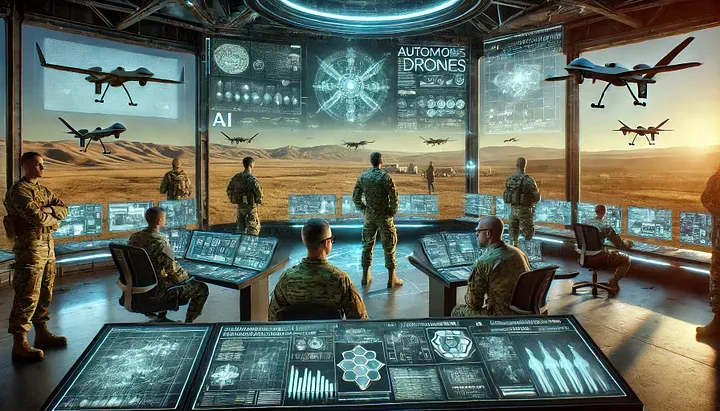The Overstated Promise of AI in Warfare

Since the inception of artificial intelligence, scholars and policymakers alike have referred to it as a revolutionary force poised to redefine warfare. The prospect of AI on the battlefield to optimize decision-making processes and reduce the “sensor-to-shooter” timeline has fascinated military strategists and defense sectors worldwide. That AI will fundamentally transform the character of war may be overstated, if not entirely misleading.
While AI offers capabilities that can enhance operational efficiency and intelligence workflows, the discourse surrounding its military applications often ignores the political, operational, and ethical limitations that accompany the technology. Much of the current hype is driven not by seasoned military professionals but by tech entrepreneurs and venture capitalists, whose motivations are rooted in economic gain rather than tactical effectiveness.
One of AI’s core promises in warfare is its potential to accelerate the sensor-to-shooter timeline, the interval between identifying and engaging a target. Supporters argue that by processing vast amounts of data in real-time, AI could enable militaries to outmatch adversaries by delivering quicker and more precise strikes. AI is the key to maintaining a lethal edge in the context of great power competition, where military capabilities may be evenly matched. However, this assumption is mainly speculative and neglects to consider the broader complexities of military engagement.
Although AI can streamline specific processes, such as optimizing intelligence gathering or automating logistical tasks, it has limitations. AI systems rely heavily on data, and while they can make predictions based on patterns, they cannot account for the fluid and unpredictable nature of war. Moreover, relying on AI to perform complex cognitive tasks could lead to the deskilling of human operators, reducing their ability to make critical decisions under pressure. While AI may offer some tactical advantages, it is far from the game-changing force it is often depicted as.
Much of the discourse surrounding AI in warfare is driven by figures from the tech industry — entrepreneurs, venture capitalists, and defense contractors — rather than military professionals with firsthand combat experience. These “tech bros” have a vested interest in promoting AI as the future of warfare, as they stand to profit immensely from defense contracts and the sale of AI-enabled technologies. This has led to a new military-industrial complex, where private companies drive military modernization, often without the rigorous empirical testing necessary for high-stakes applications.
Many tech entrepreneurs have used their platforms to shape the conversation around AI-enabled warfare, presenting it as an inevitable and necessary advancement. However, their lack of operational military experience means they cannot fully grasp the real-world implications of deploying these technologies on the battlefield. As a result, the narrative they promote is often more about selling a vision of AI-driven warfare than addressing the actual needs of military organizations.
The deployment of AI in warfare also raises significant ethical and normative concerns. Lethal autonomous weapons systems, often referred to as “killer robots,” have sparked widespread debate about the role of AI in making life-or-death decisions. While AI can enhance precision in targeting, it also carries the risk of misidentification and civilian casualties. Additionally, using AI in non-lethal capacities, such as cognitive warfare and disinformation campaigns, poses new challenges to the ethical conduct of war.
The introduction of AI into warfare blurs the lines of accountability. If an autonomous system makes a mistake, who is responsible? This accountability gap is a significant concern, undermining the moral frameworks traditionally governing military operations. Furthermore, as AI systems become more autonomous, there is a risk that they will operate beyond the control of human operators, raising questions about the ethical implications of delegating lethal authority to machines.
Another critical issue is the extent to which soldiers trust AI. Surveys of military personnel, particularly senior officers, suggest a general skepticism toward AI-enabled technologies. While younger officers may be more open to using AI in decision-making processes, senior military leaders are hesitant to trust machines, particularly in life-or-death situations on the battlefield.
This lack of trust is compounded by the fact that AI systems are not infallible. They are prone to biases, errors, and limitations in their decision-making capabilities. As such, the military’s reluctance to fully embrace AI is understandable. Trust in AI is not guaranteed, and the successful integration of AI into military operations will require addressing these concerns, both at a technical and ethical level.
While AI has the potential to enhance certain aspects of military operations, it is far from the revolutionary force that many believe it to be. The over-hyped narrative of AI-enabled warfare, driven by private sector interests, ignores the real-world limitations and ethical challenges that accompany the technology. Policymakers must take a more measured approach, focusing on empirical evidence and rigorous testing rather than being swayed by the promises of tech entrepreneurs. Ultimately, the role of AI in future warfare will depend not only on its technological capabilities but also on how well it integrates with human decision-making and the ethical frameworks that guide military conduct.
Thank you for being a part of this fascinating journey.
BearNetAI. From Bytes to Insights. AI Simplified.
BearNetAI is a proud member of the Association for the Advancement of Artificial Intelligence (AAAI), and a signatory to the Asilomar AI Principles, committed to the responsible and ethical development of artificial intelligence.
Categories: Artificial Intelligence, Military and Defense Studies, Ethics in Artificial Intelligence, Technology and Warfare, Public Policy and Defense Procurement, Security and Geopolitics
The following sources are cited as references used in research for this post:
Wired for War by P.W. Singer
The Kill Chain: Defending America in the Future of High-Tech Warfare by Christian Brose
Army of None: Autonomous Weapons and the Future of War by Paul Scharre
Artificial Intelligence and International Politics by Peter B. Haas
Command and Control: Nuclear Weapons, the Damascus Accident, and the Illusion of Safety by Eric Schlosser
Copyright 2024. BearNetAI LLC